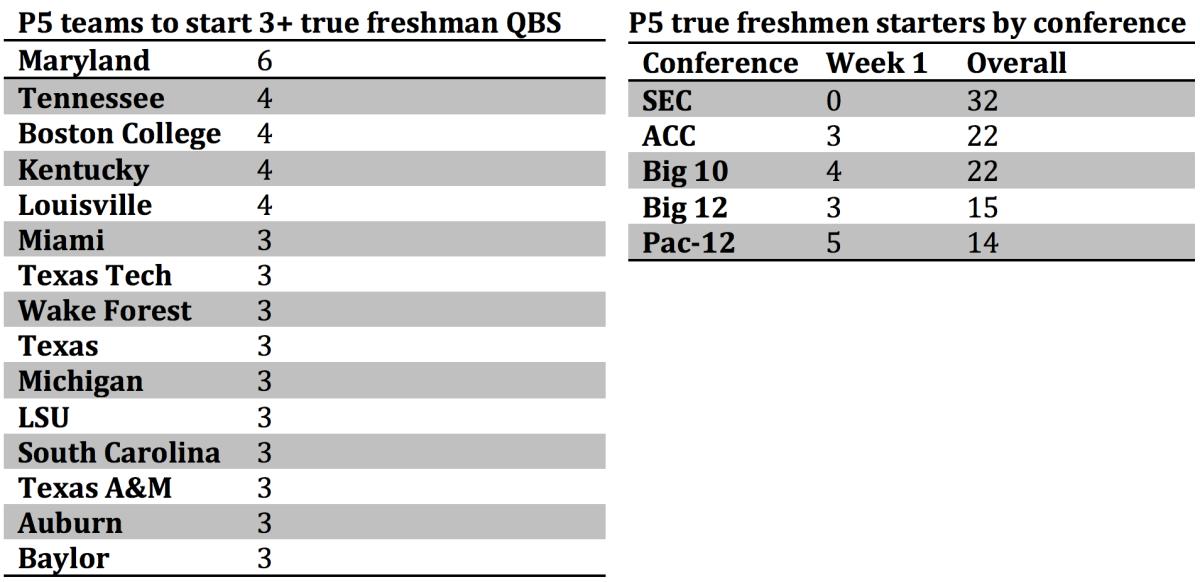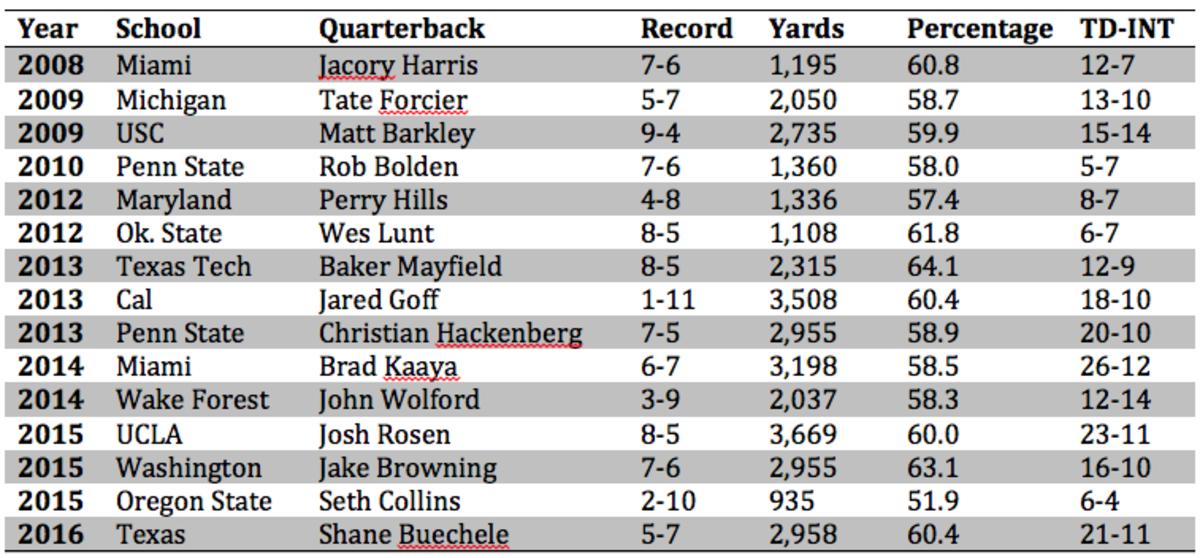Starting Them Young: The True Freshman Quarterback Trend Isn't Going Anywhere

Twice a week for up to an hour, CJ Cypher attends sessions with a private quarterbacks coach in his hometown of Atlanta.
Tony Ballard teaches Cypher the fundamentals of the position while also expanding his mental grasp of the game. A recent video of a Cypher training session shows him swiftly moving through strategically placed cones, keeping his feet at a wide base, squaring up to his target and gunning a football 10 yards into a person’s chest. “I love it!” Ballard shouts. In the classroom on the dry-erase board, he’s even more impressive. Cypher can tell you the assignments of every player on a given offensive play, read defensive coverages and identify most formations.
CJ Cypher is eight years old.
“It’s so incredible,” Ballard says, “it scares me.”
More than 100 true freshmen at the 65 Power 5 conference programs have started a college football game in the past decade, and the youth movement—one that dovetails, most say, with the rise of spread offenses in the mid-2000s—shows no sign of stopping. With only a few depth charts left open to interpretation, four true freshmen won fall camp competitions and were tabbed to start their teams’ season openers this weekend: USC’s J.T. Daniels, Nebraska’s Adrian Martinez, Minnesota's Zack Annexstad and Rutgers’s Artur Sitkowski. (Wake Forest also started a true freshman, Sam Hartman, after suspending first-team QB Kendall Hinton three games for a violation of team rules.) That could be the most ever at the Power 5 level, but it's at least the most in a decade: The 2018 group joins 15 first-year QBs at Power 5 schools since 2008 who opened the season as the starter.

Teenage quarterbacks are arriving on campus more polished than ever, something many believe is directly related to a developmental process that’s beginning earlier and earlier. The impact of that trend was on full display in January’s national championship game, when Alabama and Georgia’s title hopes came down to true freshman QBs Tua Tagovailoa and Jake Fromm.
This year’s class of freshman QBs is better-equipped for early playing time than any group Ballard has seen in his 20 years as a private quarterback instructor. Two of its brightest lights, Trevor Lawrence at Clemson and Justin Fields at Georgia, spent August pushing the incumbent starters who led their teams to the College Football Playoff a year ago. “Both will get some playing time,” says Ron Veal, another longtime Atlanta-based private coach who tutored both Fields and Lawrence. “They’re going to schools where two quarterbacks made it to the playoffs, but they’re going to play.”
Just a decade ago, that would have been crazy talk. Coaches have grown more willing to roll the dice on advanced youngsters, and the annual flood of QB transfers gives freshmen who stick around bountiful opportunities. The youth movement is also bolstered by the early enrollment trend, and by the narrowing gap in complexity between high school and college offenses, both widely featuring digestible spread schemes in which play calls are often the responsibility of hand-waving coaches on the sideline and not quarterbacks at the line of scrimmage.
“There’s a combination of factors,” says Barton Simmons, national recruiting reporter for 247Sports.com, “but the bottom line is that when they get to college, they’re just more experienced.”
It’s part of what makes college football so fun: 17- and 18-year-olds, a few months removed from their high school days, taking center stage in front of some of the most raucous crowds in sports. And the accelerated learning curve is even seeping into pro ball. Some of the best seasons by a rookie QB have come in the last decade: Cam Newton (2011), Andy Dalton (2011), Russell Wilson (2012), Robert Griffin III (2012), Andrew Luck (2012), Jameis Winston (2015), Dak Prescott (2016). According to the NFL, last year marked the 10th straight with a rookie passer starting on opening weekend, more than doubling the second-longest streak in the Super Bowl era (1968-1971). Wednesday’s trade that sent Teddy Bridgewater to New Orleans indicated that the Jets may be intent on continuing that streak with Sam Darnold this year.
The trend has trickled up from football’s lowest levels. In 2007, Tommy Tuberville, then the coach of an Auburn program that prided itself on an old-school, physical brand of football, changed his scheme and quarterback to match the high school programs he recruited. He shifted to a spread system, benched his pro-style QB and started an athletic true freshman at quarterback in Kodi Burns. “Had no choice. I saw what was happening with all the high schools,” Tuberville says. “They were all going to it. You couldn’t bring them in and make them pro-style quarterbacks.”
Auburn fired Tuberville the next season, but plenty of old-school coaches successfully shifted their quarterback prototype and scheme to fit the times, including TCU’s Gary Patterson, Kansas State’s Bill Snyder and even Nick Saban at Alabama. Today’s signing classes are full of ready-made QBs who spent their high school careers operating similar offenses to the colleges where they signed.
But that does not equate to wins. If a team is starting a true freshman at quarterback, it has “done a bad job of recruiting,” says Tuberville, now a college football analyst for ESPN.
Since 2008, seven of the 15 Power 5 teams that started true freshman quarterbacks in their season openers finished with a losing record. Maryland leads all teams in true freshman quarterbacks tabbed to start at any point in the season with six. Tennessee, Boston College, Kentucky and Louisville have started four over that stretch. Four of those five programs have something in common: They haven’t finished in the top 20 of the AP poll in a decade. To this day, only one true freshman quarterback has led his team to a national championship: Oklahoma’s Jamelle Holieway in 1985.
“I don’t think these freshmen are ready,” says Norm Chow, the longtime offensive coordinator and quarterback guru known for his run of strong-armed BYU play-callers. “It takes time to learn that position. Back in the day, a guy redshirted, sat around for two years and then had two years by himself to start.”
Some coaches are forced to play first-years. Attrition at the quarterback position has never been higher, as “impatient” quarterbacks, to use Chow’s term, choose the transfer market over the bench. On Monday, Nebraska’s Tristan Gebbia announced his intention to transfer once it was revealed that he had not won the starting job, just a week after two LSU quarterbacks made the same decision in the wake of the news that Joe Burrow would start for the Tigers. In a 2016 study, The Tuscaloosa News found that only 37.2% of quarterbacks in the Southeastern Conference end their careers at their original school. Interestingly, the SEC has started 10 more rookie QBs than any other Power 5 league.
Transfers often leave the depth chart wide open for freshmen to be thrust into action. Injuries forced Maryland to start three different freshmen during the 2012 season. Kentucky started four different rookies over a five-year stretch, in some cases replacing a former freshman starter with a new freshman starter. The numbers for freshmen starters have improved through the years: The 12 freshmen who started a game in 2017 had a better completion percentage (57% to 52%) and better touchdown-to-interception ratio (8–5 to 5–5) than the five freshmen starters in 2007.
Many point to early starts and the year-round training for QBs, whether through 7-on-7 teams or private QB coaches—or, in most cases, both. Football parents are starting to financially support quarterback training for their sons like golf and tennis parents have for years. “I’ve been approached a couple of times,” Chow says. “They’re willing to pay $1,000 to go out there an hour.”
Ballard, a former quarterback himself at Florida A&M, began training QBs 20 years ago in Tampa before starting Football University in Atlanta. At any one time, he works with 15 middle school and high school athletes in one-on-one sessions, while also tutoring about a dozen college players. One of his most recent prominent prospects, five-star Davis Mills, the top-ranked quarterback in the 2017 class, signed with Stanford. Veal, who played quarterback for Arizona in the late 1980s, has been training quarterbacks for 15 years and manages about 35 at one time. Two of those just happened to be the No. 1 and No. 2 ranked quarterbacks in the 2018 signing class. Fields started working with Veal when he was a sixth-grader, Lawrence in his seventh-grade year. “Trevor sprouted a little quicker than Justin did. You knew what was coming with Trevor,” says Veal. “I’d be a fool if I said I taught him how to throw a football. That’s a gift from God.”
Lawrence is the bell cow of the 2018 group of freshman QBs, a 6'6", 215-pound gunslinger who won 52 games and two state championships and passed for 13,908 yards and 161 touchdowns in four years as a starter at Cartersville High in Georgia. 247Sports graded him at a 0.9999, the highest mark for a quarterback in at least a decade of signing classes. During his first spring practice as coach at Cartersville in 2014, Joey King watched Lawrence, then an eighth-grader, hit a varsity receiver in the helmet earhole with a slant pass. Lawrence read the coverage properly, fired a strike, and the receiver wasn’t ready. “We looked at him, ‘Oh we got something here,’” King says.
A few months later, the coach was meeting with presumptive starter Miller Forristall, a 6'4" junior, about moving to tight end. King didn’t have to explain much. I get it. I can’t make the plays this kid is making, Forristall, now a tight end at Alabama, told his coach.
Lawrence graduated early and enrolled at Clemson in January, giving him an extra spring practice to digest the offense, similar as it may be to the scheme he ran at Cartersville, and adjust to college life. Six of the top-10 quarterbacks in the 2018 class enrolled at the mid-year point. “We had one that enrolled early, and he’s light years ahead of where he would have been,” says Doug Ruse, quarterbacks coach and offensive coordinator at Tulane. “And summer workouts are so more advanced and you spend so much more time with the players in the classroom. They’re learning scheme. I think the whole process is just sped up 10-fold what it was just six or seven years ago.”
Early development, though, is the key. Being a quarterback is the “hot thing,” Ballard says, with football-crazed parents starting kids at incredibly young ages. CJ Cypher is old compared to some. “You’d be amazed at the emails and direct messages I get of people sending me film of five-year-olds and six-year-olds.”
Is that his next project, he’s asked? Ballard laughs. “A five-year-old? I ain’t doing that.”
How’d they fare? True freshman to start at Power 5 schools in Week 1

Four freshman QBs to watch in 2018
(247Sports composite rankings used)
Trevor Lawrence, Clemson
Hometown: Cartersville, Ga.
Measurements: 6'6", 215
Recruiting ranking (overall/position): No. 1/1
Eye-popping high school stats: 52–2 record as a starter
Competition: Kelly Bryant, a senior, led the Tigers to the College Football Playoff in his first season as a full-time starter, but coach Dabo Swinney left the starting competition open through camp and insisted that Lawrence will see playing time early even after listing Bryant atop the depth chart.
Justin Fields, Georgia
Hometown: Kennesaw, Ga.
Measurements: 6'3", 225
Recruiting ranking (overall/position): No. 2/2
Eye-popping high school stat: Posted an 18–2 TD-to-INT ratio in a senior season shortened by injury
Competition: True freshman Jake Fromm’s steady hand advanced Georgia to the national championship game, and he’s expected to take most of the game snaps, at least early on. Still, it’s tough to leave the dual-threat Fields on the sideline completely. Georgia coach Kirby Smart says he won’t redshirt.
J.T. Daniels, USC
Hometown: Irvine, Calif.
Measurements: 6'3", 210
Recruiting ranking (overall/position): No. 16/3
Eye-popping high school stat: 73.2% completion percentage in final two seasons
Competition: The Trojans announced Daniels as their starting quarterback after a camp in which he dazzled, showing off a “deadly accurate” arm, as coach Clay Helton put it. For a kid who graduated high school a year early, he’s now the guy at a major program.
Adrian Martinez, Nebraska
Hometown: Fresno, Calif.
Measurements: 6'2", 220
Recruiting ranking (overall/position): 139/14
Eye-popping high school stat: averaged eight yards per rush as a junior
Competition: Martinez will become the first true freshman to start a Nebraska season opener in the school’s illustrious history. He beat out redshirt freshman Tristan Gebbia in a two-man camp battle. First-year coach Scott Frost expects both quarterbacks to play this season.
